What Type of Nunchucks Should You Use? Here's a Full Breakdown
November 14th, 2025
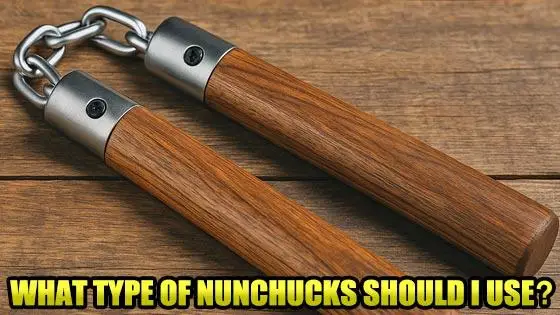
Choosing the right pair of nunchucks can be surprisingly confusing, especially when there are so many styles, materials, and names floating around. Some people call them nunchaku, others say nunchucks, and beginners often type numchucks when they search for them online. No matter how you spell it, the goal is the same. You want a pair that fits your skill level, feels good in your hands, and matches the kind of training you plan to do. Before you pick up your next set, it helps to understand the most common types and what each one brings to the table.
Foam Nunchucks
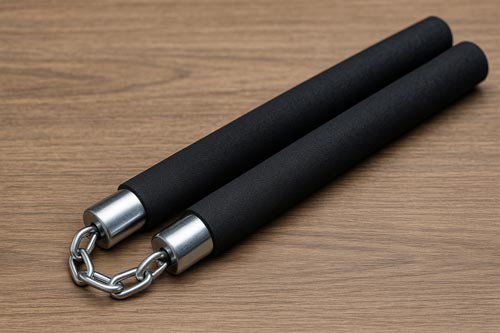
Foam nunchucks are the starting point for most beginners because they take away the fear factor and let you focus on learning the movements without getting bruised every few minutes. Even though they are lighter than wood or metal, they still give you a real sense of how nunchaku swing, rotate, and change direction. That makes them ideal for anyone who is brand new to training or for younger martial artists who want to practice safely.
Foam nunchucks usually have a rigid inner core wrapped in thick padding, so you still get solid structure without the painful impact that comes from harder materials. They are also the easiest pair for practicing fast wrist rolls, quick transitions, and basic freestyle moves because they are forgiving when you misjudge your timing.
A lot of people underestimate foam nunchucks, but the truth is that most skilled practitioners started with them, and they remain one of the smartest choices for building confidence and control before moving to heavier styles.
Wooden Nunchucks
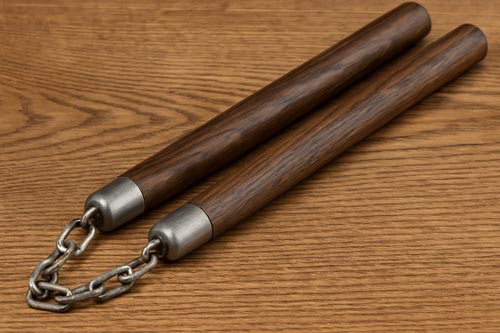
Wooden nunchucks are the next logical step once you feel comfortable with the basics and want something that feels more traditional. This is the material most people picture when they think of classic nunchaku, especially the kind used in traditional karate schools. Wood adds weight, stability, and a more realistic sense of momentum, which immediately changes the way each swing or strike feels. Because wooden nunchucks carry more force, every movement demands cleaner technique. Small mistakes that foam would forgive are easier to spot when using wood, and that makes them a solid choice for improving precision and control.
There are many types of wood used in nunchaku, and each one has its own personality. Lighter woods give you speed and easier transitions, while heavier hardwoods increase power and provide a more grounded feel. The finish also matters. Smooth polished wood glides comfortably during rolls, while slightly textured or grooved surfaces add extra grip for fast changes in direction. Even the shape can vary. Some wooden nunchucks are straight and uniform, while others taper slightly toward the ends to adjust the balance point. These differences may seem small, but they influence how the weapon behaves during forms, drills, and freestyle training.
Wooden nunchucks are best for students who already understand basic striking paths and want to develop better timing, accuracy, and flow. They are also great for anyone who appreciates the classic feel of natural materials and wants a pair that looks and performs like the traditional versions used in Okinawan martial arts. If you plan to train regularly and want to sharpen your technique, wood is one of the most rewarding materials you can work with.
Metal Nunchucks
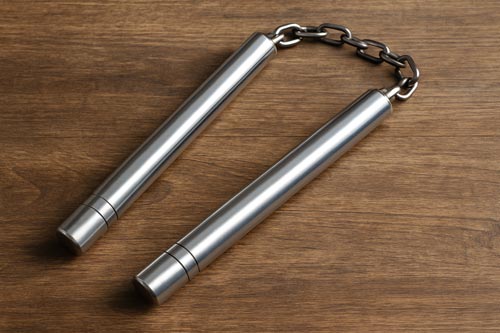
Metal nunchucks are designed for practitioners who want a heavier, more demanding training experience. The extra weight adds a noticeable challenge to every strike, spin, and transition, and that makes metal an advanced option rather than a beginner choice. When you swing a metal pair, the momentum builds quickly, so your technique has to stay sharp and controlled. There is less room for sloppy form, which is why metal nunchucks are often used to develop strength, forearm conditioning, and raw power in each movement.
Most metal nunchucks are made from aluminum or steel. Aluminum versions are lighter and easier to maneuver, while steel models offer a dense, solid feeling that pushes your endurance. Some designs are smooth and polished, while others have knurled or textured grips to keep the handles from slipping during fast routines. Because metal does not flex or absorb impact the way foam or wood does, every misjudged swing can sting, so these should only be used by people who already understand proper control and striking paths.
One of the biggest benefits of metal nunchucks is the feedback they give you. The weight forces you to commit to your movements, and the solid structure makes it easy to feel when your timing is off. For martial artists who want to build speed and power at the same time, metal nunchucks offer a level of resistance that lighter materials cannot match. They are not ideal for tricks or freestyle routines, but for focused training and strength development, they are one of the most effective tools you can use.
Octagon and Specialty Shaped Nunchucks
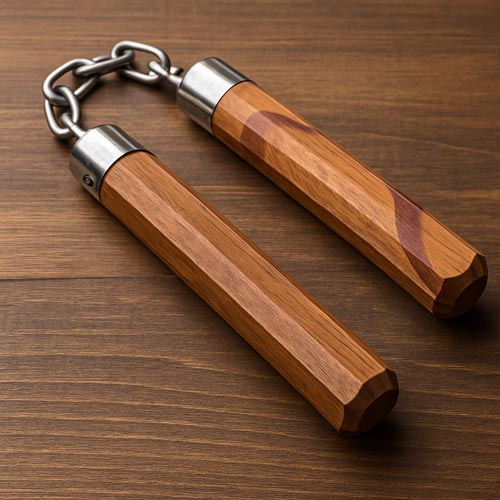
Octagon shaped nunchucks are one of the most recognizable variations, and they change the way the weapon feels in your hands. Instead of smooth, rounded handles, octagon nunchucks have flat edges that create a more defined grip. This design helps prevent the handles from slipping during fast movements, especially if your hands get sweaty during training. The flat sides also give each strike a slightly sharper impact, which is why many traditional practitioners prefer this style for strong, controlled techniques.
Specialty shapes go beyond the standard octagon and include tapered designs, squared edges, and hybrid styles used in demo teams and performance forms. Tapered nunchucks are thicker near the base and thinner near the tips, which shifts the balance forward and speeds up rotations. This makes them popular for freestyle routines and spinning techniques. Some modern versions even combine different materials, like wooden handles capped with metal hardware, to blend traditional feel with a bit of extra weight. Each specialty shape has its own advantages, but they all share the same purpose. They let you tailor the weapon to the type of training you enjoy most.
For students who want more control or want a pair that stands out from standard designs, octagon and specialty shaped nunchucks offer a noticeable upgrade. They respond differently than round styles, and that small change can improve grip security, stability, and precision. If you have been using basic round nunchucks for a while and want to experiment with something that adds personality and sharper handling, this category is a great place to explore.
Corded Nunchucks vs Chained Nunchucks
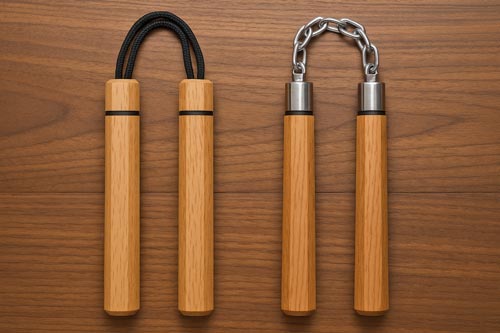
One of the biggest differences you will notice when comparing nunchucks is whether they are connected by a cord or a metal chain. Both styles have been used for decades, and each one offers its own advantages depending on the type of training you prefer. Corded nunchucks have a softer, quieter connection that absorbs a bit of the impact when the handles change direction. This makes them popular for traditional forms and techniques where smooth flow matters more than raw weight. The cord also gives you a little more flexibility, which helps during fast wrist rolls, tight transitions, and circular movements.
Chained nunchucks feel more modern and are often associated with heavier training. The chain provides a solid, consistent rotation that many practitioners enjoy because it gives clear feedback during each swing. Chains are also durable and hold up well during long sessions of striking drills or speed training. They can be louder and slightly less forgiving than corded versions, but that firmness helps build strength and precision. Metal chains also tend to make the handles swing with more stability, which is useful when practicing strong, direct techniques.
Choosing between cord and chain often comes down to personal preference. If you like smooth, fluid movement and quiet training, a corded pair is usually the better choice. If you prefer a firmer, more structured rotation and want something that stands up to heavier impact work, a chained pair will feel more natural. Many practitioners eventually use both so they can switch between fluidity and power depending on what type of training they are focusing on.
Training Nunchucks vs Performance Nunchucks

Training nunchucks are built for durability, repetition, and steady skill development. These are the pairs you use for drills, striking practice, forms, and everyday sessions at the dojo. They are usually made from wood, foam, or metal and are designed to handle the impact of thousands of rotations and directional changes. Training nunchucks tend to prioritize balance and control over appearance. Their main purpose is to help you build clean technique, improve timing, and develop muscle memory through regular practice. Whether you are working on basic spins or sharpening advanced transitions, training nunchucks give you the consistency needed to push your skill level forward.
Performance nunchucks serve a different purpose. These are the pairs used in demonstrations, tournaments, talent shows, tricking routines, and high-energy freestyle performances. They are often lighter, flashier, and more visually striking than standard training models. Many performance nunchucks include tapered handles that spin faster, polished finishes that catch stage lighting, or designs that favor speed over power. The lighter weight makes them ideal for fast aerials, wrist rolls, and showy combinations that would be harder to pull off with heavier materials. While they can still be durable, they are not meant for hard-impact striking or heavy conditioning sessions.
Choosing between training and performance nunchucks comes down to how you plan to use them. If your goal is to build skill, strength, and clean technique, a solid pair of training nunchucks is the right choice. If you enjoy fast freestyle movement or plan to perform in front of others, then performance nunchucks will help you move with more speed and flair. Many martial artists eventually keep both styles on hand so they can focus on fundamentals during training and switch to lightweight pairs when it is time to show what they can do.
Choosing the Right Nunchucks for Your Skill Level

With so many styles available, choosing the right pair of nunchucks comes down to understanding your current skill level and what you plan to practice. Beginners usually benefit most from foam nunchucks because they offer the safest way to learn the basics without worrying about painful mistakes. The lighter weight helps you focus on technique, balance, and timing, which sets the foundation for everything else you will learn. Foam is also ideal for younger students or anyone who feels nervous about swinging a harder material for the first time.
If you already have a handle on basic movements and want something that feels more traditional, wooden nunchucks are the natural next step. They carry more weight than foam and offer a solid, grounded feeling that helps you understand how momentum affects each strike or rotation. Wood also teaches control because it punishes sloppy movements in a way that foam does not. Once you can handle wood without constant bumps or mistakes, you will know your technique is improving.
For practitioners who want an even greater challenge, metal nunchucks push your strength, endurance, and precision to a higher level. Their added weight forces you to stay fully committed to your movements and maintain control from start to finish. They are not meant for beginners, but for intermediate or advanced students who want to build power and discipline, metal can be a rewarding step in your progression. Specialty shapes like octagon handles or tapered performance designs are also great for students who want a specific training experience, whether it is sharper grip control or faster spinning for freestyle routines.
You do not have to stick with one pair forever, and many martial artists eventually keep several types on hand. Foam is perfect for practice and warmups, wood is dependable for daily training, and metal helps build strength or refine advanced movements. The best choice is the one that matches your comfort level while still pushing you to grow as a practitioner.
How Different Nunchuck Styles Affect Your Training
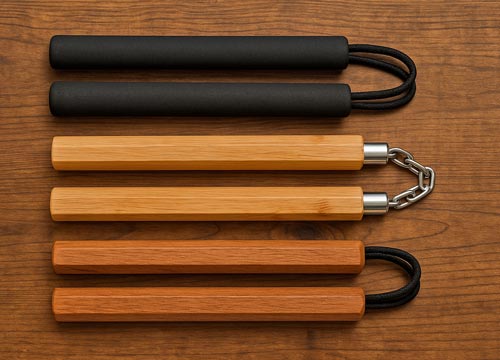
Every style of nunchucks changes the way you train, even if the difference seems small at first. Foam nunchucks help you build confidence and rhythm without worrying about painful impacts, which makes them ideal for repetition and learning proper movement patterns. When you move to wooden nunchucks, the added weight teaches you how momentum works and forces you to sharpen your control. Wood also lets you feel the path of each strike more clearly, which helps correct mistakes in technique that foam might hide.
Metal nunchucks add another layer by pushing your strength and endurance. Their weight amplifies every rotation, which means you must stay centered and committed to each swing. This builds conditioning that carries over into all other forms of training. Specialty shaped designs, like octagon or tapered handles, change the way the weapon turns in your hands. These subtle differences influence grip security, rotational speed, and how quickly you can change direction during advanced movements.
Corded and chained nunchucks also affect your training in unique ways. A soft cord offers more flexibility and a smoother flow, which is useful for tight transitions and controlled forms. A metal chain provides firmer feedback and a consistent rotation, making it better for developing power and precision. Performance nunchucks shift the focus toward speed and flair, helping you build smoother rolls, aerial tricks, and freestyle combinations. Training nunchucks, on the other hand, emphasize accuracy, structure, and long-term skill development.
As you progress, these differences help shape your overall style. Speed focused practitioners often gravitate toward lightweight or tapered designs, while traditional martial artists prefer the solid feel of wood. Strength oriented students may spend more time with metal pairs to build control and conditioning. Understanding how each style influences your training makes it easier to choose the right tool for your goals.
Where to Find the Right Nunchucks for Your Training

Once you understand the differences between foam, wooden, metal, corded, chained, and performance based nunchucks, it becomes much easier to choose a pair that fits your goals. Every style offers its own advantages, and the best option depends on whether you are working on speed, strength, control, traditional forms, or freestyle techniques. The most important thing is choosing equipment that feels comfortable in your hands and supports the type of practice you want to focus on. A well matched pair of nunchucks makes training smoother, safer, and far more enjoyable.
If you are ready to upgrade or want to explore different materials and designs, it helps to browse a selection that includes all the major types. That way you can compare weight, handle shape, cord or chain connection, and overall feel before choosing the right pair. Whether you want something beginner friendly or a set built for more advanced training, having options makes a big difference in finding a pair that matches your personal style and experience level.
If you want to explore different styles of nunchaku and compare materials side by side, take a look at our full selection of nunchucks to see everything available. It is the best way to compare the major styles and choose nunchucks that match your skill level and training style.
You May Also Be Interested In:
- Rebreakable Board Breakdown
- Which Nunchucks Would You Choose?
- New Indestructible LED Nunchucks
- Nunchaku Buying Guide: Which Nunchucks are the Best?
- Solid Metal Nunchucks and Other Deadly Weapons
- Bruce Lee's Favorite Weapon: What Made His Nunchucks So Deadly?
- Unleash Your Inner Ninja: Choosing Nunchucks for Combat and Competition
Leave a Reply
























